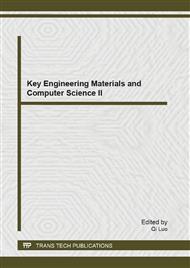[1]
N. C. Masson, E. F. de Souza, and F.Galembeck, Colloids Surf. A, vol.121, (1997), pp.247-255.
Google Scholar
[2]
O. Masala, E. J.L. Mcinnes, and P. O'Brien, Inorg. Chem. Acta, vol. 339, (2002), pp.366-372.
Google Scholar
[3]
M. Ishikawa, H. Enomoto, M. Maisuuka, and C. Iwakura§, Electrochim Acta, vol. 40, (1995), pp.1663-1668,.
Google Scholar
[4]
M. Férid,and K. Horchani-Naifer, Mater. Res. Bull., vol. 39, (2004), pp.2209-2217.
Google Scholar
[5]
Z. W. Xiao, G. R. Hu, Z. D. Peng, K. Du, and X.G. Gao, Chinese Chem. Lett., vol.18, (2007), pp.1525-1527
Google Scholar
[6]
O. Masala, P. O'Brien, and G. Rafeletos, Cryst. Growth Des., vol.3, (2003), pp.431-434.
Google Scholar
[7]
B. Boonchom, and N. Phuwongpha, Mater. Lett., vol.63, (2009), pp.1709-1711.
Google Scholar
[8]
B. Boonchom, and N.Vittayakorn, Mater. Lett., vol.64 no.3, (2010), pp.275-277.
Google Scholar
[9]
B. Boonchom, and R. Baitahe, Mater. Lett. vol.63, (2009), pp.2218-2220.
Google Scholar
[10]
Information on http://geb.uni-giessen.de/geb/volltexte/2002/819/pdf/MaassKai-2002-09-11.pdf
Google Scholar
[11]
B. Boonchom, and C. Danvirutai, Ind. Eng. Chem. Res. vol.47 no.16, (2009), pp.5976-5981.
Google Scholar
[12]
R.D. Adams, R. Layland, and C. Payen, Polyhedron, vol.14, no.23, (1995), pp.3473-3480
Google Scholar
[13]
F. Amroussi, A. Moqine, and A. Boukhari, Eur. J. Solid State Inorg. Chem. vol. 34, (1997), p.161
Google Scholar
[14]
D. Riou, P. Labbe, and M.Goreaud, C.R. Seances Acad. Sci Ser. C, vol.307, no. 16, (1988), pp.1751-1756.
Google Scholar
[15]
E. Steger, and B. Käbner, Spectrochim. Acta, vol. 24A, (1968), pp.447-456
Google Scholar
[16]
E. J. Baran, R.C. Mercader, A. Massaferro, and E. Kremer, Spectrochim. Acta, vol.60A, (2004), pp.1001-1005.
Google Scholar
[17]
A. Boukhari, A. Moqine, and S.Flandrois, J. Solid State. Chem. vol.87, (1990), pp.251-256
Google Scholar
[18]
Y. Du, Y. Xiong, J. Li, X.Yang, J. Mol. Catal. A vol.298, (2009), pp.12-16.
Google Scholar
[19]
M. Touaiher, K. Rissouli, K. Benkhouja, M. Taibi, J .Aride, A. Boukhari, and B. Heulin,Mater. Chem. Phys., vol.85, (2004), pp.41-46.
DOI: 10.1016/j.matchemphys.2003.11.032
Google Scholar
[20]
A. Handizi, A. Boukhari, E. M. Holt, J. Aride,and S.Flandrois, Mater. Res. Bull., vol.28, (1993), pp.1241-1247.
DOI: 10.1016/0025-5408(93)90171-9
Google Scholar
[21]
M.J. Mahesh, G.S. Gopalakrishna, K.G. Ashamanjari., Mater. Sci. Semicon Proc., Vol.10, (2007), pp.117-123.
Google Scholar
[22]
H. Ino, K. Hayashi, T. Otsuka, D. Isobe, K. Tokumitsu, and K. Oda, Mater. Sci. Eng., vol. A304–306, (2001),pp.972-974.
Google Scholar


